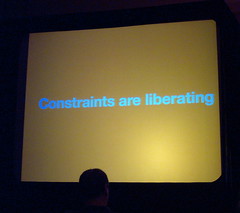 Constraints are
LiberatingOriginally
uploaded by Sean Mountcastle.
Constraints are
LiberatingOriginally
uploaded by Sean Mountcastle.
The OSCON Thursday Keynotes had the following speakers:
- Conference Announcements – Nat Torkington, Conference Chair, O’Reilly Media, Inc.
- TCP/IP and Shipping Containers – Nick Gall, MetaGroup
- High Order Bit: Secrets Behind Ruby on Rails – David Heinemeier Hansson, 37Signals
- Enterprise IT: Open Source Powerhouse – Kartik Subbarao, HP
- Computational Origami: From Flapping Birds to Space Telescopes – Robert Lang
- Interview: Mitchell Baker – Mitchell Baker, Mozilla Foundation
- Identity 2.0 – Dick Hardt, Sxip Identity
Below are my notes from the keynotes (notes from keynotes? sounds redundant) Nick Gall was up first with a short 15 minute presentation comparing TCP/IP packets to 20 ton shipping containers. His argument was that the invention of the shipping container in 1956 (I think) spurred the global economy (and globalization) because it was flexible (you didn’t have to open the container except at origination and destination and various vehicles could handle the containers over sea and land). The standards/protocols that we use in the internet enable new uses not thought of when originally developed. After that DHH was up with a quick talk about the Secrets Behind Ruby on Rails. No real secrets here, first he explained that RoR is an integrated stack of web-app frameworks written in Ruby. Accordingly, RoR is interesting because it follows convention over configuration (works for most people, most of the time), changes are instant (no XML situps, no recompiling, relaunching — just a simple refresh of the browser), finally RoR ships as a complete, integrated and familiar stack using a single language (Ruby). Some choice quotes: “Use it, break it, fix it, trash it, change it”, “Flexibility is overrated” and “Constraints are Liberating”. Following DHH came Kartik from HP — I originally thought this was going to be yet another marketing keynote, but thankfully it wasn’t too bad. He compared open source to the ocean (water) with its ability to flow into the cracks (helping enterprises glue together their important IT infrastructure). He compared the closed source world to a desert (earth) in need of water. He then compared those who take OSS but don’t give back to a swamp (when all the water comes in and none leaves that’s what you get), finally he said the perfect compromise is Venice, Italy a city built upon the earth but surrounded (and throught, due to canals) by water. Kartik was certainly enthusiastic, but I was glad he only had 15 minutes. Robert Lang was next — he didn’t seem to fit from the conference notes, so I was curious why he was invited to speak. But I was pleasantly surprised. His talk was about the art of origami (paper folding, without cutting it) and how it has evolved and within the last 20 years or so has really exploded due to the use of computers to mathematically model the paper folding, allowing some never-before Origami tricks (like making insects or fish with 400+ scales). He also mentioned that NASA used these techniques for folding up a lens so it would fit on the space shuttle. You should really check out his work, it is amazing. The penultimate keynote was simply an interview of Mitchell Baker from the Mozilla Foundation by Nat. I’m sorry, but I was totally uninterested so you’ll have to look elsewhere for the details of that interview. Finally, Dick Hardt from Sxip (pronounced skip) gave a talk on Identity 2.0 — I had thought this was going to be another marketing attempt for his company, but even though it did push his company and take some digs at the competition, his presentation style was amazing and engaging — when it was done, I wanted to watch it again. It was rapid fire a few words or picture(s) per slide running through slides amazingly quickly (about one per second, though he paused at times). Unfortunately, it doesn’t look like Sxip has a Ruby library yet for their Identity 2.0 SDK (actually, I couldn’t find it on their redesigned site — last time I went there I found a PHP version). Finally, PG put up his talk from Tuesday night on his website: http://www.paulgraham.com/opensource.html And, is anyone else, who’s a first time OSCON attendee (and travelling to Oregon for the first time) wondering what Tillamook and Multnomah are? I finally looked them up in the wikipedia: Evidently Tillamook is a county in Oregon named after the Native American Tillamook tribe. Multnomah is also a county in Oregon named after the Native American tribe of Chinookan people.